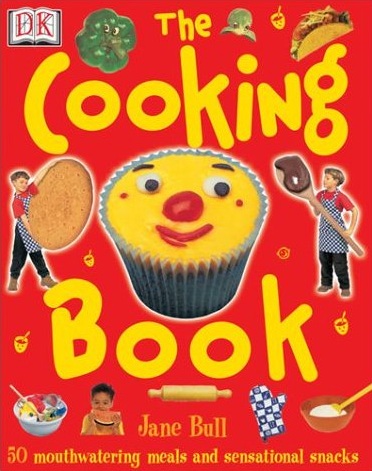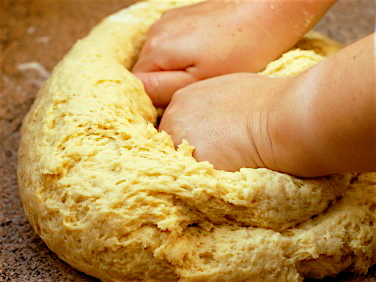
cookingbook, l
(article, Zanne Miller)
[%pageBreakSettings maxWords=700] Since they were old enough to know what we were doing, my daughters have always baked with me. Cakes in the shapes of cats and snowmen and hearts, depending on the holiday. Cupcakes decorated like bats and ghosts for Halloween. And Christmastime last year heralded a weeklong adventure of making cookie lists, buying supplies, choosing just the right fancy sugars and tins, and delivering the goodies to our friends. Baking sweet treats is a frequently requested Saturday-afternoon or sleepover activity, and I try to say “yes” more often than “no.” But it’s a lot of work, a lot of shopping, and a lot of sugar. So my girls have learned not to ask that often. I’m no Donna Reed or Martha Stewart. I can cook, and sometimes I do. But I’m also a single mom with a busy full-time job and active six-year-old twin girls. I’ve been known to go out of my way — and occasionally through a drive-through — to keep things simple at dinnertime. [%image cookingbook float=left width=200] Last year, shortly after beginning kindergarten, my daughter Julia brought home a book from the school library. The Cooking Book, read the childlike scrawl of the title. A happy-faced cupcake decorated the cover. I tried not to groan. But the book — this unprepossessing, consciously naïve book — changed our lives. The shift wasn’t immediate. I compromised my mother-of-the-year award (again) by hiding the book in the magazine rack, covering it with the newspaper, and pretending more than once not to know where it was when Julia asked to read it. One Sunday morning — shortly after the arrival of the first overdue notice from the school library — she found it. “I know what we can do today,” she announced, pulling the book out from behind her back as a surprise. “Bake bread.” And while I hesitated for a second, reviewing my mental list of excuses — too busy, out of ingredients, tired from working all week — it’s impossible to say no to a six-year-old who doesn’t want to watch TV on a Sunday morning, who wants to try something new and is standing in front of you looking very pleased with herself. After a trip to the store for yeast, we got started. The bread — a simple mix of flour, water, salt, and oil — was like stringy play-dough. We made funny faces (imitating the ones in the book) and pretzels and tried a few cookie-cutter shapes. We brushed egg and butter on top of the shapes and baked them and ate them with even more butter. They were surprisingly good, if not a little odd-looking. “Nothing like homemade bread!” my daughter Clio crowed. She sounded a lot like the little girl in the old commercial where the dad praises the yummy chicken dinner and the mom (dressed in ruffly apron) reveals her secret: “It’s Shake’n Bake.” I expected Julia to chime in with, “And I helped!” My daughters told their teacher about it the next morning as if we’d been on vacation: “We baked homemade bread!” When I picked them up that night at childcare, they wanted to do it all over again. I hesitated at first, but then I remembered that packet of yeast I’d already opened, as well as the fun we’d had the night before. And really, it didn’t take that long. So I suggested pizza crust. Since then, we’ve made some kind of bread at least once (and usually twice) a week. After all, I don’t usually need to go to the grocery store just for flour, yeast, salt, and water. Our breadmaking has been the answer to the part of me that cries out for a simpler life, a life where weekdays don’t just mean rushing to and from school and childcare each day, a life that lets childhood be a little more of a meandering path rather than a forced march. In the middle of our busy weeks, we slow down and spend time together doing something other than playing (or working) on the computer. We form a team: You get out the ingredients while I find the measuring cups. The end result is nourishing in more ways than one. “Love doesn't just sit there, like a stone,” the novelist Ursula K. LeGuin wrote in [%bookLink code=0060512741 "The Lathe of Heaven"]. “It has to be made, like bread, remade all the time, made new.” In the kitchen on bread night, my daughters take turns kneading the dough, plunging their just-washed hands in the mix, while I figure out what else to make for dinner. A little gets on the floor, but I’ve learned it’s no big deal. “That’s the fun of baking! Getting messy!” they remind me. They’ve gotten savvy enough over the past several months to know when we need just a little more flour or a little more water, a teaspoon at a time. The make-your-own pizza is in regular weekly rotation. Drop biscuits, which go with everything, require almost no supervision. We’ve pored over recipes together, and I’m proud that my daughters can tell the difference between a ciabatta and a pugliese. We’ve even started making a list of the other breads we’d like to try: focaccia, challah (they want to braid it), and banana bread. [%image promo-image float=right width=400 credit="Photo: iStockphoto/esemelwe" caption="Many hands make light work."] We’ve also made Amish friendship bread, a sweet bread with cinnamon topping that takes 10 days to make. Then you share the bread as well as the starter; a friend brought some over when we moved into our house, and it is hands-down amazing for breakfast. Unless it dies on another busy mom’s counter (this has happened), the starter theoretically will outlive its makers. When she comes in the door, our 11-year-old babysitter routinely sighs, “Your house always smells so good!” I know it’s the sourdough starter in the fridge, or the fresh baguettes cooling on the counter. (Although one day it was the rotting bananas I kept meaning to throw away.) I promised to teach her how to fill her own house with the same aroma. I am fooling the neighborhood kids into thinking I am some kind of domestic goddess with this bread-baking thing. “Not to worry,” I told my friend Michelle, “I’ll also teach them how to hammer a nail straight.” It’s not all pretty perfection. Pizza crusts continue to be trial-and-error; fortunately, pretty much everything tastes good with tomato sauce and cheese on top. We’ve had our share of brick-hard baguettes, the result of too much handling. And we’ve shed a collective tear over at least one charbroiled biscuit. [[block(sidebar). h1.Featured recipe]] But I love that we can share this, and that we are all learning about process while we all learn about patience: Thirty minutes versus 20 really does make a difference. Overnight means overnight. And in the case of the Amish Friendship Bread, 10 days really means 10 days. And while we knead the dough or stir the yeasty water and flour together, our conversations meander from what they want to be for Halloween to what’s funny about their friends to what they want to be when they grow up: a baker, naturally, but artist, pizza deliverer, and scientist have also made the list. Like I said, I’m no Donna Reed. I still bark out orders to hurry up more than I’d like to in the morning, and I still arrive breathless and harried at the after-school program at least once a week. But then we all head home to make our bread. p(bio). Zanne Miller is a writer and a busy mom of two who serves as the communications director for the School of Journalism and Communication at the University of Oregon in Eugene. She and her daughters are currently planning this year’s sugary holiday baking extravaganza.

cookingbook, l

reference-image, l

promo-image, l

feature-image, l

featurette-image, l